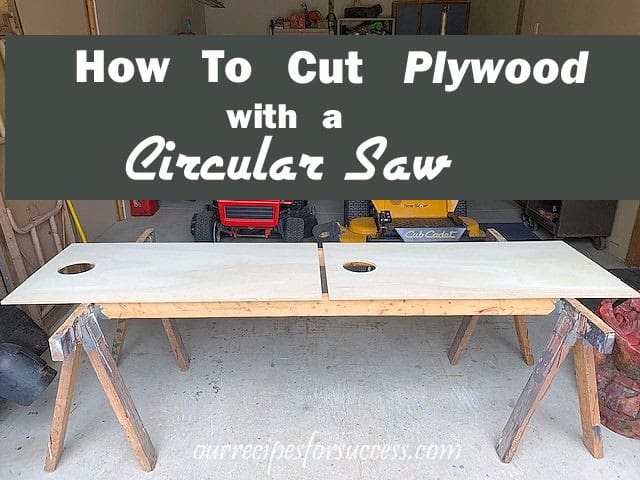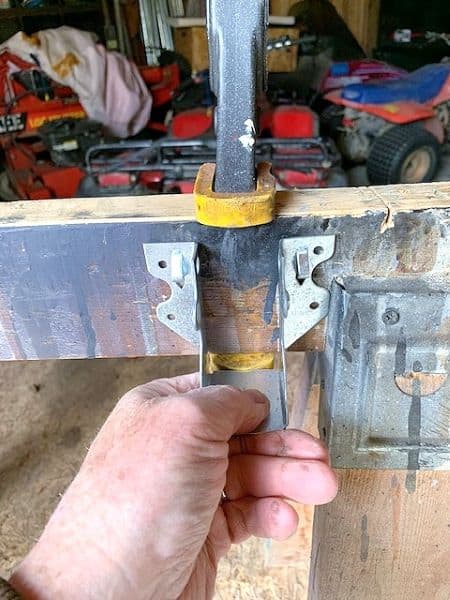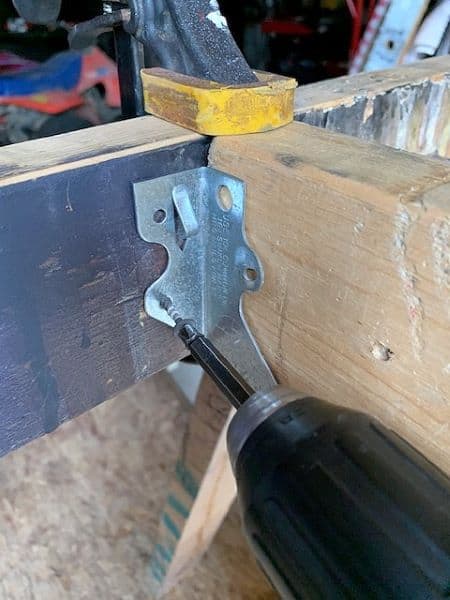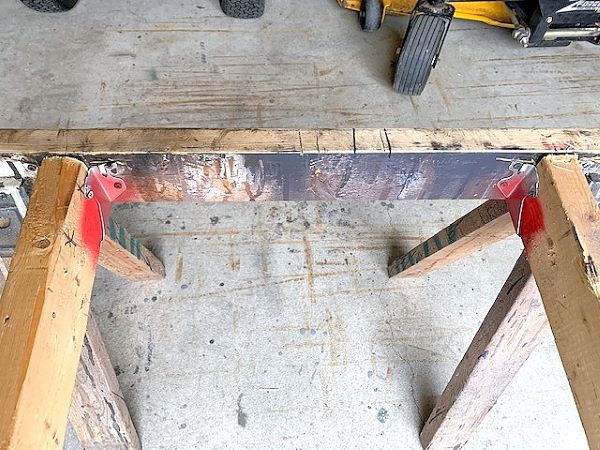In this article, I am going to share with you two of my favorite tips for cutting plywood with a circular saw. These two tips will allow you to properly support a full sheet of plywood and make nice straight cuts. The added benefit is you can typically make these cuts all by yourself.
My simple sawhorse modification will fully support the plywood and by using a few items most folks have in their shop you can make straight cuts like the pros. We’ll look at the materials and tools you’ll need and how to get started.
In this article, we will be providing you with a few links to some products for pricing and informational purposes. We are required to let you know some of these links are “affiliate links”. This means if you click on a link and make a purchase, we could make a small commission, at no extra cost to you. This helps offset the cost of maintaining our website. Now, let’s get started.
When Should I Consider Using These Plywood Cutting Tips
Table of Contents
That’s easy! Anytime you are cutting a piece of plywood. Whether you’re cutting a full sheet of plywood in half or have a partial sheet that’s too awkward to handle for cutting on a table saw. Unless you are more than just a hobbyist at woodworking and have invested hundreds, or thousands, of dollars in special equipment, you will benefit from using these tips.
The circular saw is one of the tools in our “basic woodworking toolkit” for DIY homeowners. They are fairly inexpensive and versatile. When armed with a circular saw and using these simple techniques, you’ll be able to make safe, straight cuts comfortably. No more binding and stalling the saw blade either.
HowTo Support A Sheet Of Plywood While Cutting
If you look out on the internet, you’re going to find a couple of different options that frequently come up. One option requires you to notch the top 2×4’s on your sawhorses and a couple 8 foot 2×4 studs and fitting them together like a puzzle. Making these cuts so they fit together nicely can be a little tricky, plus it reduces the overall strength of your sawhorses.
The second more popular option you typically find involves laying four 2×4 studs or a sheet of dense foam insulation on the ground. Then you lay your sheet of plywood, to be cut, on top of this material. Now the fun begins. You crawl around on your hands and knees marking and cutting.
FYI, I’m over 60 years old and my motto is to always try to work smarter, not harder. There has to be an easier, more user-friendly option other than crawling around on my hands and knees. That’s when I came up with the below modification for my existing sawhorses.
Sawhorse Modification For Supporting And Cutting Plywood
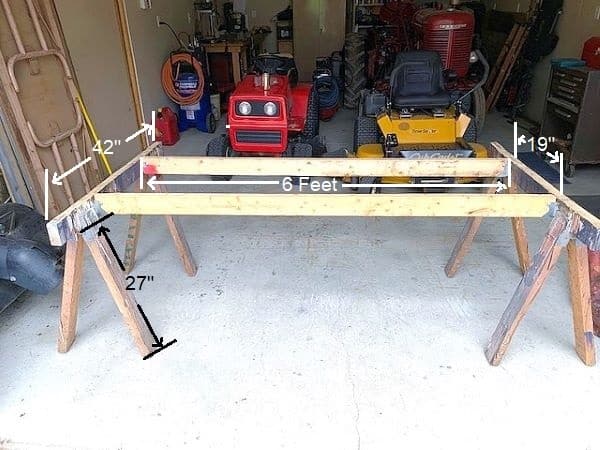
As you can see, my sawhorses are made from an inexpensive set of brackets but don’t let them fool you. These sawhorses are over 20 years old and have had plenty of hard use. This modification has not affected their normal use, stackable storage, and this new modification can be easily assembled in just a couple of minutes.
Here is a list of the materials you’ll need to put together a set of sawhorses and add the plywood supporting modification to them. They are easy to make, they’re sturdy, and are stackable for easy storage.
This modification will work on any sawhorse with the top board (typically a 2×4) that is oriented with the 4-inch dimension in the vertical position. Simply attach two 2×4 hanger brackets, on each sawhorse, so that the top of the board sitting in the hanger will be flush with the top of the sawhorse board. I spaced mine roughly 19 inches apart, between the sawhorse legs and it works well.
Cut two 2×4 studs, 6 feet long, and set them in the hanger brackets. I recommend installing at least one screw through the hanger into each end of the 6 foot 2×4’s, to hold the assembly together. That’s it, you’re done! For additional support, you could attach a second set of hangers toward the ends of the top sawhorse board, outside the legs.
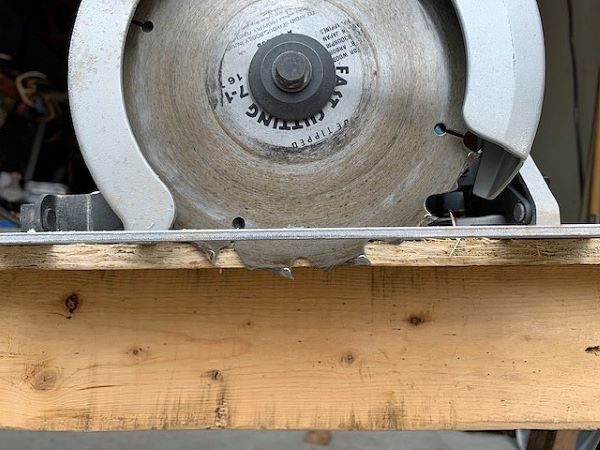
As with any of the above-mentioned options, you have to adjust the depth of your circular saw blade so it just cuts through the material you’re cutting. This is done for a couple of reasons. Firstly, this is just good work practice whenever operating any saw (circular or table saw). In the event of a slip or accident, it can help limit the extent of the injury sustained. Secondly, and more obviously, it will help prevent cutting too deep and hitting a sawhorse or hanger brackets with the saw blade. This would ruin a saw blade and could cause flying debris. I trimmed the brackets off down to the top screw, using an angle grinder with a cut-off wheel, to help prevent this.
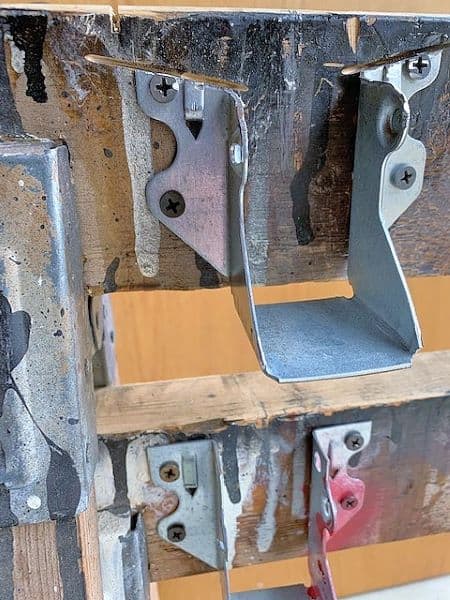
What You Need To Make Straight Cuts With A Circular Saw
We’ve already addressed an important part of this above by properly supporting the material to be cut. This prevents the material from sagging and flexing, which can pinch saw blades and cause all sorts of problems.
The second key to making straight cuts with a circular saw is to use a guide. There are circular saw guides you can purchase, but many of them can be expensive. Another inconvenience is that many circular saw ripping guides have a part of the guide that mounts on the circular saw. This requires you to attach and remove the bracket every time you want to make a rip cut.
By using a few tools and materials, you may already have, you can create your own guide that can provide nice straight cuts. By simply clamping or securing a straight edge to the plywood and running the circular saw’s plate, or base, along the straight edge you can make nice straight cuts.
Making straight cuts is important because it can help reduce wasted material and eliminate the need to make additional cuts to clean up rough edges. The best example I can offer is from our “Free Cornhole Board Plans” article. By making straight, precise cuts you have the ability to cut four “official size” cornhole board tops from a single sheet of plywood. And with today’s lumber prices, that’s a huge saving.
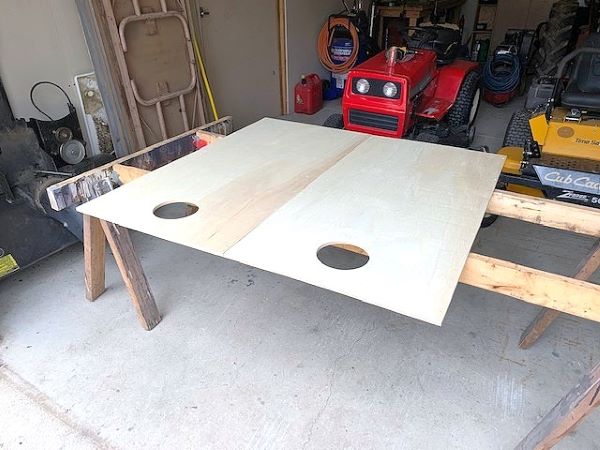
Below is a list of the tools and materials you’ll need to make your own DIY circular saw guide for cutting plywood.
How To Make Straight Cuts With A Circular Saw
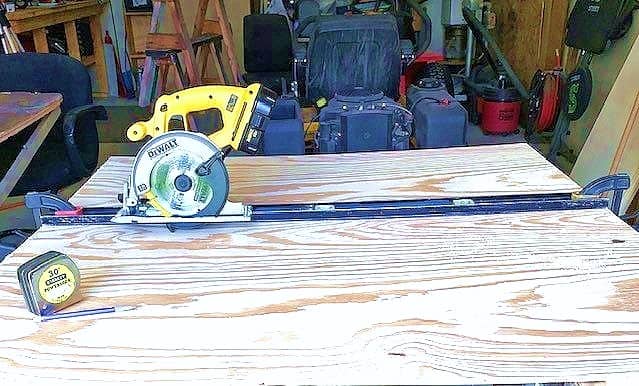
The saw blade on all circular saws are not out on the edge of the circular saw’s base, referred to as the “plate”. They are typically “offset” by a couple inches. The edge of the plate is what will actually run against the straight edge or guide. You must first start by finding out what that offset is for your circular saw.
With the circular saw unplugged, for safety purposes, measure from the edge of the plate to the side of the saw blade. This will give you the offset you’ll use for your saw.
Next measure and mark the location of the cut to be made on both edges of the plywood. From those marks, measure over the above “offset” distance and clamp the straight edge on that mark. Repeat the same step for the opposite end of the straight edge. The straight edge should be clamped parallel to the desired cut location by the “offset” distance.
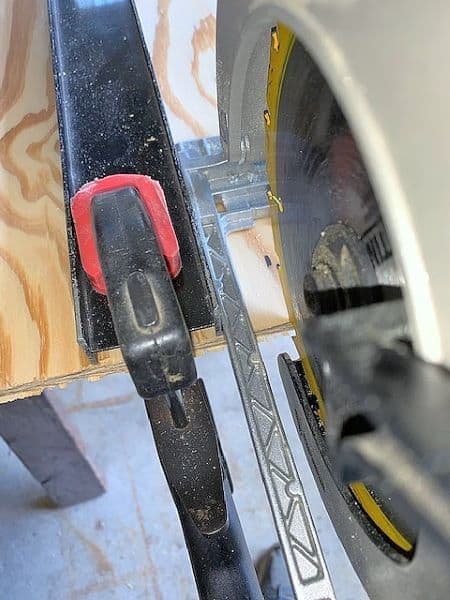
Verify the guide to cut location by holding the saw against the straight edge and visually verify that the saw blade is lined up with the cut mark and the edge of the plywood. As mentioned above, it’s a good practice to adjust the depth of the saw blade to cut through the plywood by about 1/8 of an inch and to avoid hitting any of the sawhorse brackets.
To make the cut, keep light pressure on the circular saw holding it against the straight edge. Never apply excessive downward pressure on the saw either. That can cause the plywood to flex in areas that are not directly supported, which can cause issues. Once you make a few cuts and get comfortable with the process, you’ll rarely go back to a table saw.
If you’re making cuts for a project that needs crisp, clean cuts, I’d like to pass on a few extra tips from a Bob Villa article. Number one, be sure to use the correct saw blade. A blade with a higher tooth count (60 teeth vs 24 teeth). They will provide a much cleaner cut.
The second tip is to have the “good side” face down when cutting with a circular saw. If you are using a table saw, the good side should be face up. And the third tip is to apply masking or painter’s tape on the good side, along the entire cut line. This helps prevent chipping and splintering.
Conclusion
By using these circular saw cutting techniques and tips you’re sure to have a successful project outcome. The clamped straight edge guide is great for making nice, straight cuts in any type of sheet material. Whether you’re making a crosscut or rip cut, you won’t be disappointed.
And the plywood supporting sawhorse modification can be used for more than just cutting. Lay a sheet of plywood on it to make a work surface. It’s perfect for working on materials that need to be sanded and painted or for assembling a project. They also make a great table for a family gathering or for setting things out at a garage sale. The possibilities are endless.
Don’t shy away from a project that involves cutting a piece of plywood. By using these tips you can make these once feared cuts safely by yourself. So brush the dust off that circular saw and get to work.
If you have any comments or questions, you can leave them in the comments section below or you can email us at [email protected]. FYI, we do not collect or share email addresses. We will only use them to reply to your comments or provide answers to your questions. We are also required to let you know that some of our links are “affiliate links”. This means if you click on a link and make a purchase, we could make a small commission, at no extra cost to you. This helps offset the cost of maintaining our website. So, if you like what you’ve seen, please be sure to give us a “Like” and “Share” on Facebook and Instagram too. Thank you for reading and good luck with all your home projects!

